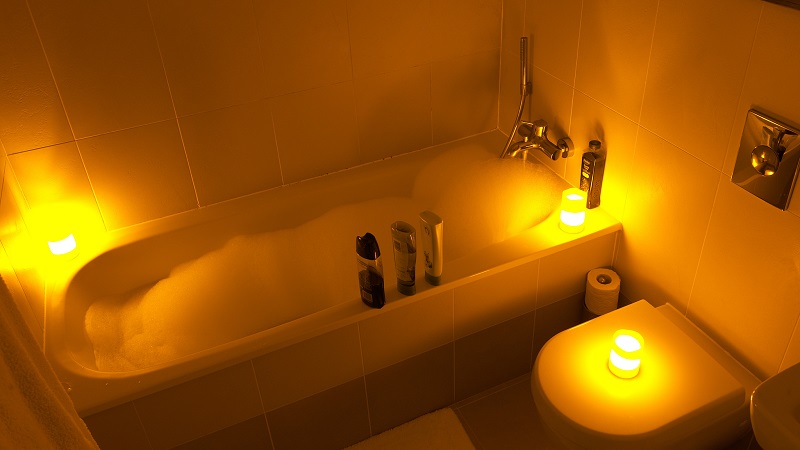You don’t have to go to an expensive spa to relax and achieve momentary bliss. You can have the same luxurious bath experience in your own home, and on your own terms, without spending a fortune or going somewhere public to get it.
Illustration by Sam Woolley. Photo by Bob Peters.
Before You Begin: Clean Your Tub
Before you hop in the tub, there are a few things you should do beforehand that will optimise your experience. For starters, give your bathtub a deep cleaning. I know, you want to get to the relaxing part, but you won’t feel so relaxed if you see some weird gunk floating around in your bathwater while you’re trying to unwind.
A quick scrub with some citrus and salt should freshen up your tub, but if it’s been a while since its last deep clean, most natural or store-bought cleaners might not be enough. Oven cleaner can make your old ceramic tub look brand new, and a power drill can make the actual scrubbing process a lot easier. The tub is the most important thing to clean, but it’s not a bad idea to clean your entire bathroom. After all, you’re trying to create a relaxing environment, and that’s much easier to do if everything is spick and span.
Make a DIY Bathtub Caddy for Keeping Your Relaxation Tools Nearby
Once you’re in your bath, the last thing you’ll want to do is immediately hop out to grab the book you’re reading, or change the music because you forgot. And you’re probably better off not trying to set a glass of water (or cocktail) along the edge of the tub. A bathtub caddy, or bathtub tray, lays across the width of the bathtub and allows you to keep drinks, books, magazines or even gadgets close by. You can set everything up on the tray before you even start running the water, so by the time you climb in, you can go right into relaxation mode. If you buy one in the store or online, it can cost you anywhere from $30 for a low-end mode to $80 for a nice wooden one. You can make a nice wooden one yourself, however, for less than the cost of a low-end model.
In the video above, youtuber Ann Le shows how you can turn a simple plank of wood into a spa-level bathtub caddy. In the same vein, youtuber Jessica Lee demonstrates how you can turn three smaller wood planks into a similar caddy. It takes a little effort, but you can pick up cheap planks of wood and a small can of wood stain at a home improvement store for a few bucks. Also, you don’t need that many tools because most home improvement stores will cut your wood to size for you. You can even decorate your caddy with candles or plants to make your bathroom seem even more serene.
Set the Mood With Lighting and Music
When you walk into a spa, the first thing you’ll notice is its relaxing atmosphere. You can create a similar atmosphere at home easily just by changing the lighting and adding some soothing sounds to your bathroom. We know that light wakes us up and keeps us alert, so make your bathroom a little dimmer so you can relax. Some dimmable LEDs can make setting the mood as easy as flipping a switch or turning a dial, and some colour-changing light bulbs like the HitLights BlueWind Multicolor LED Bulb or the Supernight 16 Colours Changing Dimmable LED Bulb can change the entire colour of your bathroom with the press of a button on their included remotes. Of course, the simplest route is to close your shades or blinds, light some candles (scented if you like them) and shut off your bathroom light.
Different kinds of music can be relaxing for different people, but some music is specifically designed to be soothing. The song above, from the in59seconds YouTube channel, is based on music relaxation research from psychologist Dave Elliot at the University of Cumbria. Elliot suggests you look for songs that are slower (around 90 beats per minute or less), have a 4/4 beat, feature pianos and strings and have narrow note sequences where the notes move from low to high like the song above. Dr David Lewis, the UK’s leading stress specialist, came to similar conclusions with his research, and even assembled a list of the top 10 most relaxing tunes. We put those songs on a relaxing playlist to help you get started:
Some ambient sounds are great for relaxing as well. Noisli can play calming sounds like rain, fire, and even railroad tracks in any browser on your laptop, phone or tablet. If you can swing it, you’re better off listening to your music with a Bluetooth speaker like the Koss BTS1 (one of our favourites), or even a Sonos house-wide audio system. You can even make your own budget-friendly Sonos system with a Raspberry Pi. If you just want to listen with your phone or tablet’s speakers, that’s fine too. Just stick it in an appropriately sized Ziploc bag to make it more waterproof and set it on your bathtub caddy. Or better yet, put on a music playlist you trust and set your phone or tablet somewhere it won’t get murdered by bathwater. It won’t sound quite as nice as a dedicated speaker system, but you’ll still hear the music just fine.
Dial In the Perfect Bathwater Temperature
A good bath is all about the temperature of the water. Bathwater that’s too cool will cut your relaxation time short, and bathwater that’s too hot will just make you sweat. Generally, you want your bathwater to be somewhere between 32C and 40C by the time you get in. Some folks will tell you to shoot for a little more than the normal body temperature of 37C, and some will recommend the lower end at 33C, but it depends on your personal preference. It should feel warm when you get in, but not uncomfortably hot.
Before you start running the tap, boil two pots or kettles of water on the stove. When they’re nice and hot, slowly pour the water into the tub so its surface can begin to warm up. Now when you start running the water, the cold surface of the tub won’t instantly cool down the water you’re filling it with.
Keep Your Toasty Warm Bathwater From Cooling Too Quickly

A decent soak in the tub should last for at least 20 minutes, but hot water loses heat much more quickly than that. You can always drain some of the bathwater and run hot water from the tap, but there are other, more efficient methods.
Mark Sisson at Mark’s Daily Apple suggests you start your bath hotter than you might think. Basically, it’s better to err on the side of your bath being too hot than too cold. If it’s too cold, you have to add a ton of hot water to heat the whole tub up, but if it’s too hot, you can just drizzle cold water into the hot water.
Ambient temperature is important as well. Once you start running the bath, it’s important you keep the bathroom door shut. As Dr Piliang explains to the Wall Street Journal, this lets steam build and warm up the room so the water doesn’t lose heat to the cold air too fast. If you can’t warm up the room too much, consider running a small space heater to make things nice and toasty before you start running the water, or keeping it safely off to the side while you bathe.
According to Professor Eugene Terentjev at Cambridge University, a thick layer of bubbles on top of your bathwater will also help keep your bathwater warm longer. The bubbles insulate the top surface of the water and reduce heat loss via straight diffusion into the surrounding air and in regards to water evaporation. If you still can’t seem to retain your bathwater’s heat, commenter heidikvan at Apartment Therapy suggests you go the old-fashioned route and bake some stones in your oven for 15 minutes at 176C and then place them in the tub with you as if you were making stone soup.
While you soak in your hot bath, you should keep two things nearby: an ice cold glass of water to keep you hydrated, and a cold compress rag you can place on your forehead or neck. Both of these will help you cool down and lower your body temp if you get too hot without cutting your bath short. It’s fine to have a glass of wine or cocktail with your bath as well, but make sure it’s in addition to the cold glass of water.
Soak In Soothing DIY Bath Bombs, Bath Salts and Other Luxurious Elixirs
What spa-like bath experience would be complete without some good stuff to soak in? There are a ton of bath products you can buy out there, but you can easily create your own stuff for much less. Bath salts — not the “I want to eat your face” kind — are crystals that dissolve in your bathwater to soften and perfume the water, as well as ease your sore muscles and relieve tension.
Lindsey Johnson at Hello Glow shares six different bath salt blends you can make at home with a few inexpensive ingredients. Add two parts Epsom salt, two parts kosher salt and one part bicarbonate of soda to a few drops of your favourite essential oils. Johnson has a few combination recommendations if you’re not sure where to start, like 10 drops of eucalyptus and 10 drops of peppermint to help clear sinuses, and 10 drops of lavender and 10 drops of bergamot to help aid relaxation. If you’re looking for something more restorative, Jillee at One Good Thing recommends you make some eucalyptus mint bath oil. Mix 20 drops of eucalyptus oil with 10 drops of peppermint oil, then add 60-90mL of a carrier oil (like almond, coconut or even olive oil). The bath oil, in combination with some Epsom salt, will help soothe your sore body after a long, hard day.
If you’re interested in more of an all-in-one approach, you can make some homemade bath bombs. These tabs fizz as soon as they hit the water and infuse your bath with fragrant essential oils, Epsom salt, and make the water feel all tingly. You can even add a little bit of food colouring to them so they change the bathwater to your favourite colour.

Comments